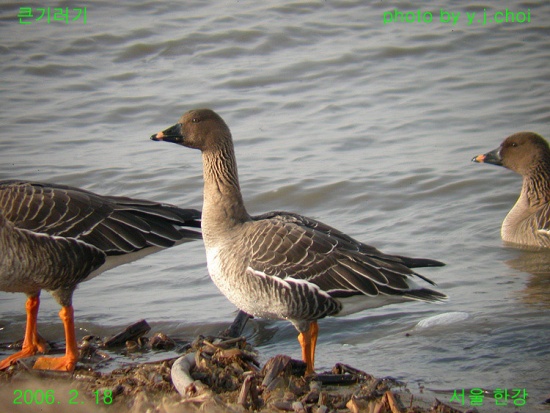m (format) |
|||
| Line 3: | Line 3: | ||
'''Includes Taiga Bean Goose, Tundra Bean Goose, and Middledorf's Goose''' | '''Includes Taiga Bean Goose, Tundra Bean Goose, and Middledorf's Goose''' | ||
==Identification== | ==Identification== | ||
| − | ====Taiga form==== | + | ====Taiga form (''fabilis'')==== |
*Dark goose with a long neck | *Dark goose with a long neck | ||
*Head, neck, and back are dark brownish | *Head, neck, and back are dark brownish | ||
| Line 14: | Line 14: | ||
In flight, tail pattern is conspicuous: narrow white terminal band, broader black band, and the innermost part white. Belly is white. Both upper and lower sides of wings are dark, without much contrast between coverts and primaries/secondaries. | In flight, tail pattern is conspicuous: narrow white terminal band, broader black band, and the innermost part white. Belly is white. Both upper and lower sides of wings are dark, without much contrast between coverts and primaries/secondaries. | ||
| − | ====Tundra form==== | + | ====Tundra form (''serrirostris'')==== |
[[Image:31557bean-goose 8053.jpg|thumb|350px|right|Subspecies "middendorffi"<br />Photo by {{user|Peter+de+Haas|Peter de Haas}}<br />Upo wetland [[Korea]], February 2007]] | [[Image:31557bean-goose 8053.jpg|thumb|350px|right|Subspecies "middendorffi"<br />Photo by {{user|Peter+de+Haas|Peter de Haas}}<br />Upo wetland [[Korea]], February 2007]] | ||
Similar to Taiga form | Similar to Taiga form | ||
Revision as of 18:48, 13 April 2010
- Anser fabalis
Includes Taiga Bean Goose, Tundra Bean Goose, and Middledorf's Goose
Identification
Taiga form (fabilis)
- Dark goose with a long neck
- Head, neck, and back are dark brownish
- Lightest on the back
- Underside is lighter
- Bill is quite long
- Very variable with regards to extent of black and orange
- Orange often found on the distal part and almost always more extensive than in the Tundra form
- May be a narrow white edge between bill and feathers on the head, especially above the bill.
In flight, tail pattern is conspicuous: narrow white terminal band, broader black band, and the innermost part white. Belly is white. Both upper and lower sides of wings are dark, without much contrast between coverts and primaries/secondaries.
Tundra form (serrirostris)
Similar to Taiga form
- Neck is shorter and heavier
- Bill is shorter than in the Taiga form (not much longer than it is high)
- Birds with more than a small orange spot near the tip of the bill are rare in this form
- Orange is always sharply defined (mostly more diffusely edged in the Taiga form)
Middendorff's Goose
The subspecies middendorfii has recently been proposed for splitting from the other two types.
- Bill is much larger than the other two, often looking like a direct continuation of the crown.
Juvenile forms are more scaly on the back and lack the white at the base of the bill.
Distribution
A small population regularly winter in the Falkirk area of Scotland.
Taxonomy
- Subspecies fabilis is often called Taiga Bean Goose (Anser fabilis) together with subspecies johanseni and middendorfii, and occurs from Scandinavia to the Ural Mountains to Lake Baikal, and into eastern Siberia (johanseni and middendorfii does not seem to be recognized by all authorities).
- Subspecies serrirostris together with rossicus is often called Tundra Bean Goose (Anser serrirostris) and occurs from Northern Russia to north-east Siberia.
Both forms occur in Europe in winter, with northernmost flocks almost exclusively belonging to the Taiga form.
The two forms (Taiga vs Tundra) are recognized as full species by several authorities, but not by the majority of current world-wide checklists so the Opus awaits further clarification.
Latest developments is that the subspecies middendorfii (Middendorff's Goose) should be split, and that this form is genetically more dissimilar from the two other forms than they are from each other.
Habitat
Breeds in Tundra and humid openings in northern forest, especially birch and coniferous forests. Winters in agricultural areas, mostly grassy fields.
Behaviour
Diet
It grazes in bean field stubbles, giving rise to its name. The diet includes crops such as grass, cereals and potatoes.
Vocalisation
<flashmp3>Anser fabalis (song).mp3</flashmp3>
Listen in an external program
References
- Birdforum thread discussing the taxonomy of the Bean Goose complex including the possibility of splitting it in three species.
External Links





